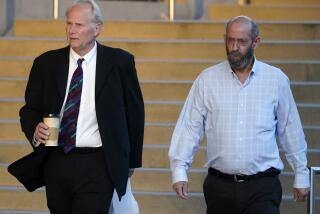Rig officials’ shortcuts may have contributed to explosion, panel is told
- Share via
Reporting from Houston — In the days before the Deepwater Horizon exploded, a wide range of workers on the rig expressed doubts, worry or confusion over decisions made by their superiors, but those concerns apparently went unheeded, according to testimony before a federal panel Tuesday.
Instead, those in charge made decisions that saved time and money, choices that may have contributed to the surge of natural gas from the oil well into the drilling vessel, where it exploded, killing 11 men and causing the worst offshore oil spill in U.S. history.
In the hours before the explosion, there appeared to be confusion in the rig’s control room over the results of a safety test designed to detect abnormalities that could mean natural gas was penetrating the well casing or plug, a witness told a Coast Guard-Interior Department panel investigating the cause of the April 20 disaster.
Days before, a Halliburton advisor had warned top BP officials verbally and by e-mail that the oil company’s cementing design could fail. Such a flaw in the cement seal could allow methane to penetrate the well and potentially leak to the rig.
Investigators on Tuesday repeatedly referred to earlier testimony by Transocean Ltd. rig manager Paul Johnson, in which he questioned BP’s decision to replace the Deepwater Horizon’s veteran well-site leader with a less experienced manager days before a crucial procedure to seal the well.
Hung Nguyen, a Coast Guard captain, painted a picture of a vessel with a divided and confusing command structure: No single person seemed to be in charge and informed of all risks on the oil rig.
The testimony also reiterated concerns about the well’s design. Experts have said that BP’s plan was flawed and potentially dangerous and have suggested the company took shortcuts that compromised safety.
Transocean, which owned the drilling vessel and leased it to BP, again came under fire for a backlog in maintenance, and investigators questioned many of the captain’s actions and qualifications.
Nguyen castigated Daun Winslow, a senior Transocean performance manager, for not knowing whether the rig owner had conducted an internal audit of the Deepwater Horizon’s safety management system to determine whether it met the International Safety Management Code.
“It’s been four months since the tragedy, and you don’t know?” Nguyen asked.
“That is correct,” Winslow said softly.
Winslow was touring the Deepwater Horizon the day it exploded and told the panel that he noticed “confusion” among high-ranking rig officials in the control room, saying the group seemed to be analyzing the results of a crucial pressure test.
Other testimony showed that BP rejected suggestions to clean out the well before sealing it with cement.
Investigators were particularly focused on testimony from Jesse Gagliano, a Halliburton technical advisor, who warned BP in an April 18 e-mail that its decision to use fewer than 21 devices called centralizers in the well could result in a “severe” gas flow problem. BP decided to use just six.
Centralizers surround drilling pipe to keep it from knocking into the side of the well’s outer wall, and to ensure a more uniform cement seal.
Four days before the explosion, BP drilling engineer Brett Cocales wrote an e-mail message expressing a note of caution regarding the centralizers, but he said he didn’t press the point. “But, who cares, it’s done, end of story, will probably be fine,” Cocales wrote.
Gagliano said a test known as a cement bond log could have helped verify whether the cement job had any abnormalities. But BP canceled that test, saving more than $100,000, according to testimony.
ron.lin@latimes.com
More to Read
Sign up for Essential California
The most important California stories and recommendations in your inbox every morning.
You may occasionally receive promotional content from the Los Angeles Times.














